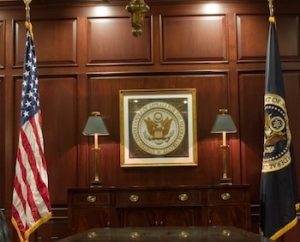 In re AT&T Intellectual Prop. II, L.P., (Fed. Cir. May 10, 2017) (Before Dyk, Mayer, and Reyna, J.) (Opinion for the court, Reyna, J.)
In re AT&T Intellectual Prop. II, L.P., (Fed. Cir. May 10, 2017) (Before Dyk, Mayer, and Reyna, J.) (Opinion for the court, Reyna, J.)
Appellant AT&T Intellectual Property II, L.P. (“AT&T”) appealed from a final decision of the Patent Trial and Appeal Board (“Board”) in an inter partes reexamination where the patent-in-suit was found invalid as anticipated.
The patent-in-suit concerns methods of compressing and transmitting digital video data. Such methods rely upon the subdividing of the digital video transmission into blocks to increase efficiency. Transform coding is used to analyze and transform each block’s pixel data into a set of numerical representations, called transform coefficients. The patent-in-suit is directed to compressing and transmitting transform coefficients in a manner that does not rely upon scanning the coefficients in any particular order, transmitting blocks of coefficients at once.
On September 14, 2012, LG Electronics, Inc. filed a request for inter partes reexamination of the patent-in-suit. LG then sought to have its request for reexamination denied. Notably, LG did not withdraw from the proceedings, nor withdraw its request for reexamination. The USPTO issued an Office Action granting LG’s initial request for inter partes reexamination based on anticipation and denied LG’s renewed request for a denial.
AT&T filed a response seeking reconsideration of the Office Action. LG filed a comment in support of AT&T’s response, urging the PTO to withdraw its stated grounds for rejection. The examiner agreed with AT&T and LG’s submitted arguments but found new grounds for rejection. Following additional arguments back and forth, and LG’s withdrawal from the case, the examiner issued a Right of Appeal Notice maintaining the new rejections. AT&T appealed, and the Board affirmed the examiner’s finding of anticipation.
AT&T now appeals the Board’s decision and argues that it was improper to institute reexamination after LG moved that its request for reexamination be denied. Additionally, AT&T challenged the merits of the Board’s finding of anticipation. The USPTO intervened, arguing that this court lacks jurisdiction to entertain AT&T’s challenge to the decision to institute reexamination, and defending the Board’s finding of anticipation.
The Court’s authority to review the Board’s decision to institute inter partes reexamination is limited by 35 U.S.C. § 312(c). The statute provides that “[a] determination by the Director under subsection (a) shall be final and non-appealable.” Id. Subsection (a) only concerns whether “the information presented in the request shows that there is a reasonable likelihood that the requester would prevail with respect to at least 1 of the claims challenged in the request.” 35 U.S.C. § 312(a). Thus, § 312(c) of the inter partes reexamination statute only restricts the Federal Circuit’s review of a determination made under § 312(a).
Additionally, Federal Circuit precedent, in Belkin International, Inc. v. Kappos established that the § 312(c) non-appealability bar was a two-step process. Step one, “the Director must make a determination ‘whether a substantial new question of patentability affecting any claim of the patent is raised by the request.’ … The statute is clear that that decision is ‘final and non-appealable.’ § 312(c).” Belkin International, Inc. v. Kappos, 696 F.3d 1379, 1382 (Fed. Cir. 2012).
The Federal Circuit does have the authority to review the issue, to the extent argued by AT&T, that without a request or requester, the Board lacks statutory authority to institute a reexamination. The Court may review that issue because it does not pertain to whether “the information presented in the request shows that there is a reasonable likelihood that the requester would prevail.” Notably, LG was the requester, submitted a request, and was still involved in the proceedings at the time the institution decision was made. Because the request and a requester were present, the Board acted within its statutory authority when it decided to institute reexamination in this case, and the Court “lacks authority to further consider the prudence or propriety of the Board’s decision.”
Finally, the Court reviewed the merits of the Board’s final decision regarding anticipation. The Court concluded that the Board’s finding of anticipation was supported by substantial evidence and affirmed the Board’s decision.
The Federal Circuit has appeal jurisdiction to consider whether an inter partes reexamination was properly instituted based on the presence or withdrawal of a party; but not based on whether information in a request shows a reasonable likelihood the request would prevail. Here, the presence of a request and requester empowered the Board to act within its statutory authority in deciding to institute inter partes reexamination in this case, and the Federal Circuit “lacks authority to further consider the prudence or propriety of the Board’s decision.”
[Troutman-Ad]
[Troutman-About]

![[IPWatchdog Logo]](https://ipwatchdog.com/wp-content/themes/IPWatchdog%20-%202023/assets/images/temp/logo-small@2x.png)


![[Advertisement]](https://ipwatchdog.com/wp-content/uploads/2024/04/Patent-Litigation-Masters-2024-sidebar-early-bird-ends-Apr-21-last-chance-700x500-1.jpg)

![[Advertisement]](https://ipwatchdog.com/wp-content/uploads/2021/12/WEBINAR-336-x-280-px.png)
![[Advertisement]](https://ipwatchdog.com/wp-content/uploads/2021/12/2021-Patent-Practice-on-Demand-recorded-Feb-2021-336-x-280.jpg)
![[Advertisement]](https://ipwatchdog.com/wp-content/uploads/2021/12/Ad-4-The-Invent-Patent-System™.png)







Join the Discussion
No comments yet.